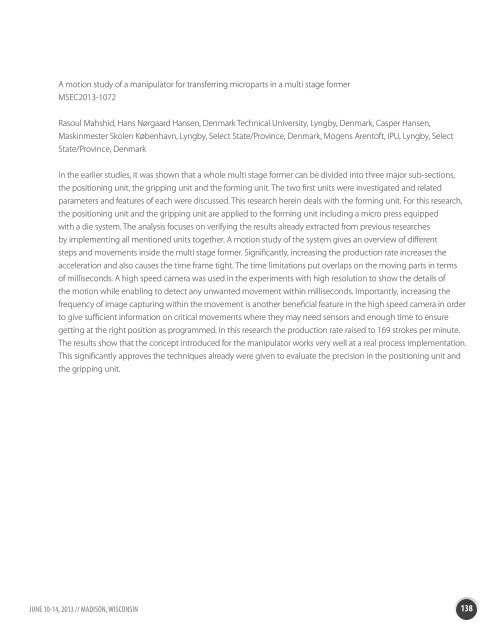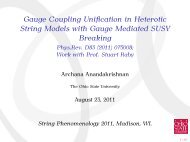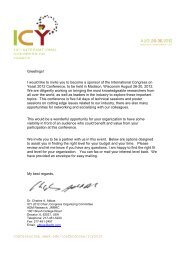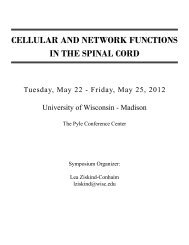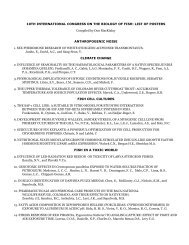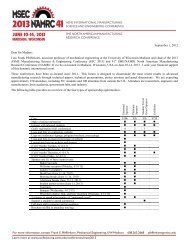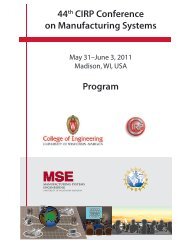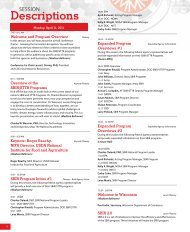- Page 1 and 2:
ABSTRACTS
- Page 3 and 4:
TABLE OF CONTENTS, cont. Characteri
- Page 5 and 6:
TABLE OF CONTENTS, cont. parts.....
- Page 7 and 8:
TABLE OF CONTENTS, cont. THURSDAY,
- Page 9 and 10:
TABLE OF CONTENTS, cont. Remaining
- Page 11 and 12:
INDEX OF AUTHORS, cont. Corney, Jon
- Page 13 and 14:
INDEX OF AUTHORS, cont. Liu, Xun...
- Page 15 and 16:
INDEX OF AUTHORS, cont. Sun, Xiaofe
- Page 17 and 18:
TIME AND LOCATION PAGE 1 PAGE 2 PAG
- Page 19 and 20:
TIME AND LOCATION, cont. PAGE 41 PA
- Page 21 and 22:
TIME AND LOCATION PAGE 81 PAGE 82 P
- Page 23 and 24:
TIME AND LOCATION, cont. PAGE 120 P
- Page 25 and 26:
TIME AND LOCATION, cont. PAGE 159 P
- Page 27 and 28:
TIME AND LOCATION, cont. PAGE 197 P
- Page 29 and 30:
TIME AND LOCATION, cont. PAGE 237 P
- Page 31 and 32:
An approach for increasing branch h
- Page 33 and 34:
Inclined ball end milling of micro-
- Page 35 and 36:
Helical plate machining in whirling
- Page 37 and 38:
Understanding the material removal
- Page 39 and 40:
Cutting force of hollow needle inse
- Page 41 and 42:
Development of a multi-arm bioprint
- Page 43 and 44:
Energy efficiency in thermally assi
- Page 45 and 46:
Measuring dynamic 3D micro-structur
- Page 47 and 48:
Visual inspection of free form glos
- Page 49 and 50:
Folding and transitions in plastic
- Page 51 and 52:
Chatter stability model of micro-mi
- Page 53 and 54:
An investigation of anisotropic beh
- Page 55 and 56:
Applicability of various cutting to
- Page 57 and 58:
Machinability analysis of Ti10.2.3
- Page 59 and 60:
Advanced FEM modeling of friction s
- Page 61 and 62:
Microcellular injection molding of
- Page 63 and 64:
Characterization of bioprinting ind
- Page 65 and 66:
Remote fiber laser processing of zi
- Page 67 and 68:
Reconciling the differences between
- Page 69 and 70:
Sustainability indicators for discr
- Page 71 and 72:
Understanding life cycle social imp
- Page 73 and 74:
Simulation of surface roughness eff
- Page 75 and 76:
A novel hybrid process for drawing
- Page 77 and 78:
Methodology for shape optimization
- Page 79 and 80:
Integrated electrohydrodynamic jet
- Page 81 and 82:
Multi-nozzle array electrohydrodyna
- Page 83 and 84:
Investigation and optimization of l
- Page 85 and 86:
Experimental study on micro-scale m
- Page 87 and 88:
Enhancing adaptive production using
- Page 89 and 90:
Feature selection for manufacturing
- Page 91 and 92:
Evaluation of fiber orientation pre
- Page 93 and 94:
Experimental study of biaxial load-
- Page 95 and 96:
Machining depth regulation and fric
- Page 97 and 98:
Feed rate optimization issues in mi
- Page 99 and 100:
Investigation of friction in needle
- Page 101 and 102:
Micro-laser assisted feasibility te
- Page 103 and 104:
Application of laser in joining alu
- Page 105 and 106:
Development and implementation of c
- Page 107 and 108:
Characterizing energy consumption o
- Page 109 and 110:
Effect of inter-particle interactio
- Page 111 and 112:
Performance evaluation of multi-sca
- Page 113 and 114:
Dual-scale cascaded adaptive stocha
- Page 115 and 116: Polycrystalline diamond turning of
- Page 117 and 118: Product-oriented sustainability asp
- Page 119 and 120: Removal mechanism and defect charac
- Page 121 and 122: Application of picosecond laser for
- Page 123 and 124: Burr formation and surface quality
- Page 125 and 126: Microcellular injection molding of
- Page 127 and 128: Unit process life cycle inventory m
- Page 129 and 130: Unit process life cycle inventory m
- Page 131 and 132: Effect of tool wear on hole quality
- Page 133 and 134: Spindle dynamics identification usi
- Page 135 and 136: LDV-based spindle metrology for ult
- Page 137 and 138: Three dimensional finite element an
- Page 139 and 140: The correlation of abrasive grain d
- Page 141 and 142: Effect of blank holder force scheme
- Page 143 and 144: Evaluation of ionic fluids as lubri
- Page 145 and 146: Line-based laser induced plasma mic
- Page 147 and 148: Requirements for moving towards liq
- Page 149 and 150: Synthesis and characterization of h
- Page 151 and 152: Lifecycle management of knowledge i
- Page 153 and 154: Virtual enterprise architectural fr
- Page 155 and 156: Energy savings opportunities of an
- Page 157 and 158: Process damping coefficient identif
- Page 159 and 160: Finite element simulation of micro-
- Page 161 and 162: Determination of constitutive mater
- Page 163 and 164: Fatigue properties and life predict
- Page 165: Ductile fracture limits of the CuZn
- Page 169 and 170: A critical factor in enhancement of
- Page 171 and 172: Constant temperature embossing of P
- Page 173 and 174: Virtualize manufacturing capabiliti
- Page 175 and 176: A product configurator for cloud ma
- Page 177 and 178: Numerical modeling of specific ener
- Page 179 and 180: Aluminum oxide nanoparticle mixed U
- Page 181 and 182: AN IMPROVED EMPIRICAL CONSTITUTIVE
- Page 183 and 184: TIME-DEPENDENT EFFECTS OF CONTACT P
- Page 185 and 186: An experimental study on edge chipp
- Page 187 and 188: Low volume aluminum forging using m
- Page 189 and 190: Experimental study of electro-plast
- Page 191 and 192: Residual stress analysis and weld b
- Page 193 and 194: Mechanical behavior of Ti-6Al-4V ma
- Page 195 and 196: Improving densification of zirconiu
- Page 197 and 198: Modeling, analysis and improvement
- Page 199 and 200: Cooling capability of cutting fluid
- Page 201 and 202: Chip segmentation in machining: A s
- Page 203 and 204: Progressive modeling: Introducing a
- Page 205 and 206: Multi-zone proportional hazard mode
- Page 207 and 208: An integrated approach to metrology
- Page 209 and 210: Empirical modeling of direct electr
- Page 211 and 212: Quality evaluation of multistage ma
- Page 213 and 214: Automated part inspection using 3D
- Page 215 and 216: The effect of warm accumulative rol
- Page 217 and 218:
Material shrinkage modeling and for
- Page 219 and 220:
Phase transformation affected quenc
- Page 221 and 222:
Key technologies of embedded gear m
- Page 223 and 224:
Manual precedence mapping and appli
- Page 225 and 226:
Thermally assisted high efficiency
- Page 227 and 228:
A new velocity estimator for motion
- Page 229 and 230:
Characterization of vacuum brazing
- Page 231 and 232:
Adaptive robust control of circular
- Page 233 and 234:
MICRO-MILLING RESPONSES OF HIERARCH
- Page 235 and 236:
An experimental study of the phenom
- Page 237 and 238:
Design of a 3-DOF compliant paralle
- Page 239 and 240:
GPGPU accelerated 3-axis CNC machin
- Page 241 and 242:
Correlating acoustic emission to ca
- Page 243 and 244:
Uncertainty analysis of tool wear a
- Page 245 and 246:
Diluted acid pretreatment and enzym
- Page 247 and 248:
Study of the effect of anode/cathod
- Page 249 and 250:
A new additive manufacturing file f
- Page 251 and 252:
A reactionary process planning algo
- Page 253 and 254:
Experimental investigation of chip
- Page 255 and 256:
Effect of ball nose end mill geomet
- Page 257 and 258:
Rapid finite element prediction on
- Page 259 and 260:
Model learning in a multistage mach
- Page 261 and 262:
VIDEO EVENT FAULT DETECTION WITH ST
- Page 263 and 264:
Combined temperature and force cont
- Page 265 and 266:
All solution based fabrication of C
- Page 267 and 268:
Review and analysis of vibration as
- Page 269:
Modeling of focused ultrasound prop


